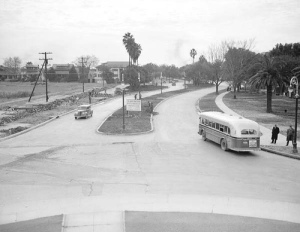Submitted by: Haley Ashe
Hello all! Hope you all have enjoyed reading these adventures in field work as much as I have. Each research opportunity, restaurant visit, casual conversation, new blog post, etc allows all of us to learn something more about this unique city some of us are fortunate enough to call home. New Orleans is a jewel and myself and my fellow bloggers have been investigating this particular facet located at Canal Street and Carrollton Ave.
Many of us have provided links and helpful photos pertaining to the development of the Lafitte Corridor. Not at an attempt of being redundant but more so out of importance, here are some more links and photos.
http://www.urbanconservancy.org/projects/carondelet-basin-greenway
This development is very important to the area and has the potential to drastically change this historical neighborhood. Interested in becoming a friend of the corridor? You can do it here: http://folc-nola.org/
This particular neighborhood has always been a microscopic example of the racial diversity of The Big Easy. Post Katrina census figures have changed slightly as far as residential make-up, but over all the figures are within similar ranges when you consider the fact that not all citizens have returned nor have all of the homes been rebuilt. Here is a comparison of the 2000 and 2010 census data. http://www.gnocdc.org/NeighborhoodData/4/MidCity/index.html
Mid-City gained its moniker from when it was literally the middle of the city in the late 19th century. Pre-contact natives had long settled the area along the natural levees of the river, avoiding the routine flooding of the lower lying areas we now inhabit today. Mid-City was fully developed by 1920 and had multiple public amenities such as public transportation (http://www.gonola.com/2011/03/16/nola-history-streetcars-the-early-years.html) , pools, parks, theaters, churches, schools, restaurants and more. In September 1926 what had begun to be known as Jesuit high school opened its doors on Banks St. and South Carrollton. (http://www.jesuitnola.org/about/about–6406.htm) Around this time as well across from what is now The Shamrock on N. Carrollton and Tulane was a stadium for our minor –> major league baseball team The Pelicans. http://nolalocal.com/new-orleans-pelicans/
Our old, beautifully decaying city has had many transformations and Mid-City has transformed right along with it. The area of Mid-City has seen many historical structures lost due to neglect and nature. Multiple city blocks along Canal Street have been leveled in the name of progression and corporate interests. Even when citizens have attempted to get involved (http://www.preservationdirectory.com/preservationblogs/ArticleDetail.aspx?id=806&catid=1) it is sometimes not enough. There are grants available through the government for citizens to preserve our city though. (http://www.nola.com/politics/index.ssf/2011/08/historic_mid-city_properties_e.html) There are also ways for concerned citizens to get involved in what is happening to their area. (http://www.npnnola.com/issues/view/8/master-planning-for-neighborhoods-in-new-orleans) What often happens is that “we” see what is going on in our city but feel we don’t have the time to devote to city meetings, or that a local government agent would not reply to a strongly worded correspondence. Because of this lack of incentive, many wonderful aspects of our city will be forever lost. I am actually alarmed at how few people are aware of the Greenway project. Claire and I have not spoken with the owners of Juan’s or Wit’s Inn yet, but I have spoken with some other Mid-City business owners, employees, residents and area visitors. Most of the individuals I have spoken with have perhaps noticed there are buildings being torn down. Aside from seeing construction, most are not aware of the future intentions of the area, which in turn has not made them aware of the future impact this project may have. While we all hope it will be positive, the past has shown that large-scale development such as this causes rent to rise and an influx of more affluent residents to move in. This is good for the businesses in the area, this is NOT good for the predominantly working-class, low-income and student aged residents calling this area home. (http://www.prcno.org/neighborhoods/brochures/MidCity.pdf) My hopes for the future is that businesses and residents alike will work together to preserve what makes this area of the city special in it’s own right.
Our research of Juan’s Flying Burrito http://www.juansflyingburrito.com/


 1908 4724 S. Carrollton Ave Juans bldg
1908 4724 S. Carrollton Ave Juans bldg
Has turned up some interesting information. Sanborn maps printed in 1898 did not contain any data for the area. I then realized that was because at that time it was only “Carrollton Ave.” and had not extended to Canal Street from Claiborne Ave. yet. However, in only 10 short years Carrollton had then developed into South and North Carrollton and was connecting to City Park. On the 1908 map what is now Juan’s was in existance. It wasn’t until the 1937 maps were we able to discern that Jaun’s had been for many years a Steam Cleaners. On the south side of the building was a movie and performance theater and on the north side of the building was a service station. An anticipated meeting with the owner and more Sanborn maps may shed light on the 60 years after it was a Cleaners.
Our research on Wit’s Inn (http://witsinn.com/) has also unearthed some interesting information as well.


 New+Orleans+1937 141 N Carrollton Wit’s Inn
New+Orleans+1937 141 N Carrollton Wit’s Inn
Wit’s Inn is home to a former pool hall in the 1970s. According to Sanborn maps printed in 1908, the location already existed, although it wasn’t until 1937 that were we able to find a map actually labeling the location as a restaurant. Claire hopes to get to speak with the owner so we can see what his sentiments are on the Greenway project and perhaps give us some insight on the neighborhood and how the businesses and residents interact.
I hope you all have enjoyed reading this as much as I have had writing it! Until we meet again.










